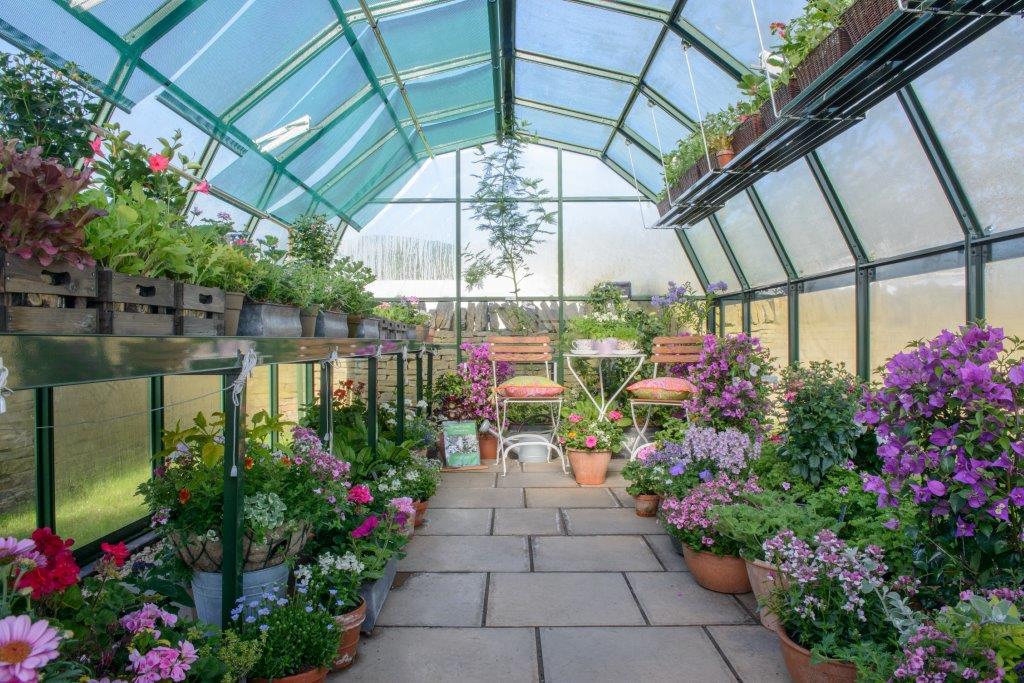
If there’s a greenhouse on your Christmas list you might need to convince a non-believer in their worth. Jean Vernon helps you state your case
A gardener without a greenhouse is a bit like a cook without a stove. Yes you can manage, improvise and still be creative, but the greenhouse facilitates much more than you might imagine. A greenhouse allows you to concoct the most divine combinations for your garden, to experiment with your ingredients and nurture the most wonderful plants. It supports your plants in a nurturing, caring environment and provides just the right conditions for plant growth.
The relationship between a gardener and their greenhouse is emotional; of that there is no doubt. But there’s solid science behind the benefits of the greenhouse. And it’s not all about your plants. A greenhouse is a haven for the gardener, a place to practice horticultural alchemy and provides space for mindfulness activities as well as lifting the spirits on those wet, cold, dull days we so often experience. It’s a shelter from the weather, a place for quiet reflection and somewhere away from the hustle and bustle of everyday life.
Lungs of the planet
But when it comes to your plants, the greenhouse is a catalyst. Cast your mind back to school when we learned about how plants make food in their leaves. Like all great food production even plants need the finest ingredients; quality ingredients that a greenhouse enhances. First they need light as the energy source for the photosynthesis process and a greenhouse harnesses the power of the sun through its glass panels. Without light your plants cannot grow. It’s as simple as that. A greenhouse amplifies the light and also provides a protected place for your plants to grow. Plants need water, which the attentive gardener will provide to their plants and they also need carbon dioxide, which is present in the air. The water molecules in the reaction are broken down and release oxygen into the atmosphere. Plants use the carbon dioxide and make carbon chains in the form of sugars and plant foods which they use to fuel growth and store the carbon chains in the structure of their leaves and fibres making them into virtual carbon sinks. That’s why planting trees and growing plants is good for the planet. As long as there is good ventilation and airflow in your greenhouse there will be plenty of carbon dioxide. Remember in the absence of light (at night) your plants will respire and produce carbon dioxide that will enrich the air in your greenhouse with CO2 and this will be used when the sun rises by the plants for photosynthesis. And the waste product from photosynthesis – OXYGEN and that is why trees and plants are regarded as the lungs of our planet. In a nutshell the greenhouse provides, enhances and supports the perfect conditions for photosynthesis; the method in which plants make food and grow.
Plant needs
Warmth and humidity promote plant growth. Plants need moisture, warmth and light to grow. A greenhouse stabilises the growing environment by buffering the ambient temperature and protecting the plants from extreme cold. This extends the growing season at both ends, so in late winter and early spring it enhances the growing conditions for plants and allows them to start into growth earlier than they would when growing outdoors. This enables the greenhouse gardener to sow earlier and reap the benefits of the extended growing season, with earlier flowers and harvest. By sowing successionally, i.e. a few seeds every couple of weeks a greenhouse grower can reap a harvest well into autumn especially by using the greenhouse environment to nurture late sown seedlings.
Minimising problems

The greenhouse can also protect your plants from a range of pests and diseases. By keeping on top of small pest outbreaks, your greenhouse can become an oasis free from flying pests such as adult aphids, egg laying butterflies and all manner of other plant munchers. You won’t keep them all out because your ventilation provision will allow some access, but you can minimise problems significantly and also utlise a range of biological controls that can virtually be confined to your greenhouse growing space where they can deal naturally with any pest outbreaks without the need for toxic chemicals. That means you can grow organic produce for the family too!
Some plant diseases such as blight can be minimised by growing tomatoes in a greenhouse environment. The fungal spores are less likely to reach your plants and the growing conditions inside the greenhouse are less conducive for the fungi to infect your plants. By choosing blight resistant varieties you can virtually eradicate the chance of tomato blight on your greenhouse crops, which is a huge advantage over growing outside.
But the benefits of the greenhouse are more than the sum of their parts. Add up the positive vibes, health giving properties and the way a greenhouse enhances your growing potential and to be honest there are few other ways to improve your gardening, your garden and your life so easily. Ask any greenhouse owner what they would do differently and they will all say buy a size bigger than you think you need and invest in a quality greenhouse every time. You won’t regret it and you really won’t be disappointed.


